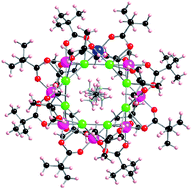Storing quantum information in chemically engineered nanoscale magnets†
Abstract
We review the implementation of quantum information processing using quantum spins and pulsed spin resonance techniques. Molecular magnets, nanoscale clusters of coupled transition metal ions, offer various potential advantages over other spin systems as the building blocks of a quantum computer. We describe the strategies which must be employed in order to implement quantum algorithms in such nanoscale magnets and explain why, when evaluating the suitability of any physical system for embodying a qubit, it is essential to determine the phase relaxation time appropriate for an individual molecular spin. Experiments utilising pulsed spin resonance techniques show that the phase relaxation times in at least some molecular magnets are long enough to permit multiple qubit operations to be performed.

- This article is part of the themed collection: Molecular spintronics and quantum computing

 Please wait while we load your content...
Please wait while we load your content...